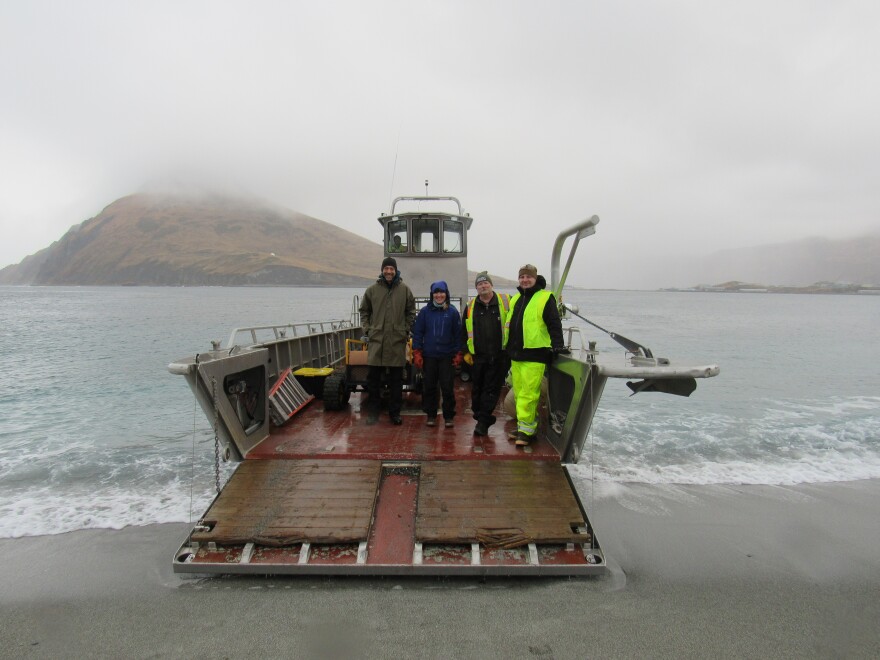Engineers have taken down one of Unalaska's four meteorological (MET) towers after it was damaged in a fall storm. Its loss isn't expected to compromise the city's ongoing energy study testing the feasibility of a local wind farm.
On Hog Island, workers have been preparing a MET tower for winter, anchoring it deeper into the ground. That way, when high winds blow and heavy rain falls, it'll stand up to the elements and avoid damage.
Doug Vaught is a consultant with the Anchorage-based company V3 Energy, LLC. He said reinforcement is important because the city is using these towers to collect data for an energy study that'll determine if Unalaska can produce electricity from wind energy in the future.
One structure by Pyramid Valley's Icy Creek has already been removed after an October wind storm gusted 85 miles per hour and knocked it over.

"The loss of that tower means very little," said Vaught. "It was meant as a reference point. We have enough data for that reference point, so the loss of the tower does not affect the project."
If the city decides to pursue a permanent wind farm, he said turbines wouldn't be at risk of storm damage. While test towers are light-weight and designed to obtain data as inexpensively as possible, turbines are built for the long haul with a concrete foundation.
And beyond the one damaged tower, Vaught said Unalaska's wind study is going well. Two of the remaining MET structures have been up for more than a year, tracking wind speed, turbulence, and probability.
Based on preliminary data, he said another Pyramid Valley location, near Veronica Lake, would probably be the best bet for a wind farm. It also has the benefit of existing infrastructure — like roads and power — that would lower installation costs.
"Part of the whole focus of the project is to look at sites that can actually be constructed," he said. "That's really the limiting factor of any Alaska project: There are lots of windy spots — but they need to be not only near a community, but near existing development."

Vaught said a number of Alaska communities are having success in incorporating renewable wind energy into their grids, including Kotzebue and Kodiak. The latter city produces nearly 100 percent of its power from renewable sources.
But it's still unclear how a wind farm would stack up to Unalaska's diesel powerhouse, which has been its only electricity provider since World War II.
Consumers might not see a big drop in their utility bills, but Vaught said the costs would likely be more consistent.
"You can think of it as a price stabilizer," he said. "You are — for years into the future — displacing a known percentage of fossil fuel. So should fossil fuel prices rise abruptly for events way out of the community's control — say, a war — you've banked a savings."
That said, the city will have to decide whether those savings are enough to justify a permanent wind farm. Already, the study phase is set to cost $420,000.
Vaught said fossil fuel power plants are usually easier than renewables. They're inexpensive upfront, have high energy output, and use well-established and understood technologies.
"There's an entire ecosystem of infrastructure and industry around their extraction, refining, transport, and usage," said Vaught. "But the consequence is they produce a lot of carbon. One of the driving reasons for renewable energy is to offset the carbon implication of burning fossil fuels."
That's a compelling reason for Unalaska to give wind energy some serious consideration, according to city engineering technician Mark Morrow.

"We could maybe get 10 percent [of our power] from wind," said Morrow. "Doug [Vaught] says he wouldn't be happy with three percent. But I would, because it's just less diesel up the stack."
City officials will decide whether to proceed after the remaining MET towers finish collecting data in the next year or so.
If they go forward with wind, Vaught said they'll also need to decide how much energy they hope to produce, how they'll integrate turbines into the existing grid, and how they'll store the energy so utilities aren't at the mercy of inconsistent winds.
"Unlike a standard hydroelectric [system,] where you can bank the water if you have a large enough dam and use it as you need it, wind power can only produce power when the wind blows," said Vaught. "So the larger the wind system, the bigger potential mismatch where you're producing more power than you need — or you're not producing power when you need it. This is where one potentially needs batteries to bank energy."
Morrow said the city is currently developing an energy storage system for that purpose.
While it's a lot to figure out, Vaught said wind energy may be worth it if Unalaska really aims to minimize its environmental footprint.

"If the community wants to do its part in offsetting carbon dioxide from fossil fuel production, then wind energy plays a role," he said. "If the decision is purely economic, that might lead to a different answer. But this is my personal view: If one is concerned with climate change, then one should be concerned with carbon."
The city has marked funding for renewables as one of its lobbying priorities.
In addition to exploring wind energy, the city is considering purchasing power from a private company developing a geothermal project at Makushin Volcano. Ounalashka/Chena Power LLC is expected to share more details on that effort next month.






